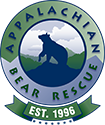ABR received another eleven-month-old cub from just outside the national park. She is the smallest of all the recent cubs, weighing just 8.5 pounds. With such a low weight, and her obvious starvation and dehydration issues, it is nothing short of a miracle that she has survived. We don’t know what happened to her mother, but it seems probable that she has been on her own for some time. It’s not at all a certainty that she will survive, but we’ll certainly do our best. She went to the UT College of Veterinary Medicine to be examined by Dr. Sullivan and his team. We have a couple of photos – you will see that Cub #239, nicknamed Snowflake Bear, looks even smaller on the examining table than our other recent, tiny cubs.
Snowflake had an abscess on her neck that Dr. Sullivan lanced and sutured.
This photo of her little paw shows how dehydrated she was. She was administered IV fluids and antibiotics while at UT. Dr. Sullivan prescribed the usual worm medicine, antibiotics, and pain medication.
When she returned to ABR, she was placed in the Cub Nursery. She lapped a bit of warm bear milk replacement formula and went to sleep. Curator Janet will give Snowflake 3 ounces of the formula every 3 hours, night and day. This is the routine that is followed with the very young cubs we admit in the spring, but little Snowflake, though nearly a year old, is no bigger than a typical two to three month old cub.
Cub #239 is the most fragile of the cubs currently in residence. Our dedicated curators will do everything they can to help her survive and grow, and we sincerely hope that it is possible to bring her back to health.






